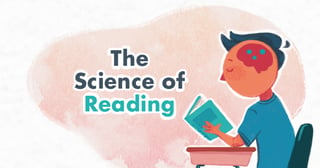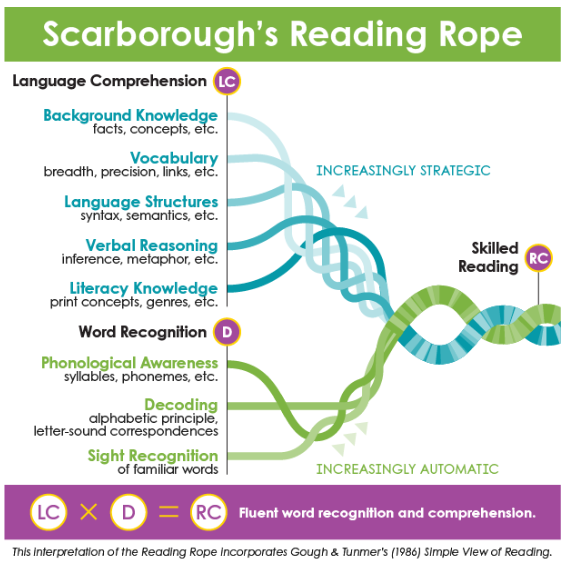
Reading is one of the most important skills students learn in school, and the level of reading proficiency a student develops has a significant impact on his or her opportunities for lifelong learning and success. This is one of the primary reasons that tutors strive to improve their practice in teaching this critical skill.
During the last few years, a phrase that has caught the attention of many educators is the Science of Reading (SoR). In this article, we will explore the SoR and discuss how it can help tutors and students.
What is the SoR?
The SoR is a body of research that helps us to understand the cognitive processes that are essential for learning to read. It encompasses more than 40 years of scientific research by experts in the fields of education, special education, literacy, psychology, neurology, and includes evidence from tens of thousands of studies.
The Key Elements of Reading Comprehension
After extensive analysis of SoR research, the National Panel of Reading (Teaching Children To Read: An Evidence-Based Assessment of the Scientific Research Literature on Reading and Its Implications For Reading Instruction, 2000) identified five elements essential to reading development:
Phonics
The alphabetic principle is the idea that words are made of small units of sound (or phonemes) and that the letters represent those phonemes. Phonics instruction helps students learn to connect the letters and letter blends with the corresponding phonemes.
Phonemic Awareness
The goal of phonemic awareness is to enable students to develop the skills to isolate, or segment, phonemes and blend them together to make up words. Learning to segment, blend, and manipulate phonemes, enables students to decode (sound out) new words as they read and encode (spell) words as they write.
Vocabulary
While phonics focuses on being able to decode and encode words, vocabulary skills focus on knowing the meanings of the words. The larger the students’ vocabularies, the more fluent their reading becomes.
Comprehension
Reading is meaningless without comprehension. Comprehension means understanding words individually as well as texts as a whole.
Fluency
Fluent readers are able to sound out words effortlessly, and they instinctively focus on comprehension. They read with expression, and they can explain what they have read in their own words.
Models that Demonstrate the SoR Approach
The Simple View of Reading
According to Gough & Tunmer (Decoding, Reading, and Reading Disability, 1986), a student's reading comprehension is the product of his or her decoding skill and language comprehension. The theoretical framework is outlined in the Simple View of Reading model. The key idea is that both decoding, or word recognition, and language comprehension, understanding the words and sentences we hear, are necessary for reading comprehension.
Word Recognition
Word recognition is the process of translating written words into speech, and incorporates phonics, phonemic awareness, spelling, and sight words.
Language Comprehension
Language comprehension encompasses vocabulary, language structure, background knowledge, and fluency.
The Simple View of Reading model states that reading comprehension (RC) is the product of word recognition (WR) and language comprehension (LC).

Scarborough’s Reading Rope
In 2001, Dr. Hollis Scarborough created the Reading Rope to convey how the different “strands” of language comprehension and word recognition are interconnected. When these component strands intertwine, it results in skilled reading.
The Orthographic Lexicon
The key to reading fluency is to help students learn to recognize words instantly without having to sound them out each time they come across the same word. A reader’s sight-word memory is called the orthographic lexicon. According to Ehri (Orthographic Mapping in the Acquisition of Sight Word Reading, Spelling Memory, and Vocabulary Learning, 2014), students must be proficient in phonics in order to build their orthographic lexicon. This process is called orthographic mapping, and it requires practice in decoding and encoding words along with sufficient opportunities to read comprehensible decodable texts.
What does the SoR approach look like in the classroom?
To align more closely to what the SoR tells us, we should implement the following practices:
Explicit and Systematic Instruction
We should teach phonemic awareness and phonics skills explicitly, clearly, and sequentially instead of providing a more indirect form of instruction. For example, instead of incidentally noting a phonetic pattern on a page of the text we are reading, we should teach those phonics skills directly and systematically and then follow up with intentional opportunities for students to apply the skills purposefully as they practice reading and writing.
Multiple Reads
We should structure time for multiple readings of the same text with a different focus during each reading. For instance, a first read-through might be about decoding. The second reading might focus on vocabulary, and a final read could focus on the meaning of the text as a whole.
Phonics Skills
Sometimes students get stuck on words when they’re reading. It’s a normal stage of reading development. Some instructional approaches promote the use of cueing systems, such as the three-cueing system (also called MSV). The MSV cueing system stands for meaning, sentence structure, and visual information. When readers come across an unfamiliar word, they don’t look at the word itself but instead look at cues around it (such as pictures) to recognize it.
The SoR evidence doesn’t support the use of the three-cueing system. When a student is stuck and stops reading, the SoR says that we should prompt the student to use a phonics skill, and if a student reads the word correctly after a few attempts, we should reinforce the phonics pattern they struggled with.
Cignition uses the following step-by-step method of helping students when they get stuck on a word:
- Look through the entire word from left to right.
- Say the sounds of the word.
- Blend the sounds together.
- Break long words into smaller parts such as syllables or chunks. Then, blend the sounds together.
Decodable Text
Many reading programs use a leveled-reading approach to help students learn to read. Leveled reading involves the differentiation of instruction by placing students in groups according to their reading levels. Typically, proficient readers receive more difficult texts, while struggling readers receive easier texts, causing them to fall further behind.
The SoR, on the other hand, promotes the use of decodable readers. Decodable readers are texts that introduce words in a carefully planned scope and sequence, giving students the opportunity to apply the phonics skills they are learning and to build confidence in their abilities to read stories. According to Cheatham and Allor (2012), “The results [of multiple studies] indicate that decodability is a critical characteristic of early reading text as it increases the likelihood that students will use a decoding strategy and results in immediate benefits, particularly with regard to accuracy.”
To afford students rapid reading progress, Cignition uses high-quality decodable texts that are aligned to the criteria outlined by the U.S. government in 1985 for creating decodable texts. According to the report, this type of text should include the following three characteristics:
Comprehensible
The text must make sense. Vocabulary must be understandable. Words must be derived from students’ speaking and listening vocabularies. The stories should make sense and follow natural-sounding English patterns of spoken and written English.
Instructive
The majority of the words must be decodable based on the sound-spellings previously taught.
Engaging
The connected text must be engaging enough for students to want to read it again and again.
Conclusion
It is important for educators to understand the SoR research because it directly affects how reading is taught. With the SoR clarifying the most effective approaches for accelerating reading development, tutors can incorporate the best strategies possible for their students, enabling them to become stronger readers. Not only will students become more proficient at reading through this approach, but they are also more likely to enjoy learning to read because they can accomplish it with less of a struggle.

